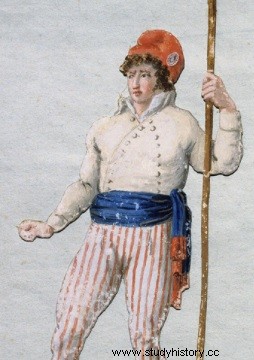 Coming from the lower classes of Paris, the sans-culottes are radical patriots who campaign for greater justice, equal political rights, and equal distribution of property. The Parisian rioters of 1789 are called "sans-culottes" because they wear trousers:under the Ancien Régime, trousers were reserved for nobles, dresses for men of the clergy and trousers for men of the Third Estate. They most often wear striped trousers of the three colors blue, white and red and wear the Phrygian cap. Their favorite songs are Ca Ira and the Carmagnole and journalists Jean-Paul Marat (l'Ami du peuple) and Jacques Hébert (Le Père Duchesne) are their main spokespersons.
Coming from the lower classes of Paris, the sans-culottes are radical patriots who campaign for greater justice, equal political rights, and equal distribution of property. The Parisian rioters of 1789 are called "sans-culottes" because they wear trousers:under the Ancien Régime, trousers were reserved for nobles, dresses for men of the clergy and trousers for men of the Third Estate. They most often wear striped trousers of the three colors blue, white and red and wear the Phrygian cap. Their favorite songs are Ca Ira and the Carmagnole and journalists Jean-Paul Marat (l'Ami du peuple) and Jacques Hébert (Le Père Duchesne) are their main spokespersons.
Origin of the name sans-culotte
Journalists from the royalist press called the revolutionaries "sans-culottes" because they replaced the culottes, a mark of the Ancien Régime in their eyes, with striped homespun trousers. The term is then adopted by the aristocrats under the Convention. It highlights the poverty, bestiality and lack of culture of the revolutionaries and is intended to be offensive. But it is used on the basis of an opposition with the term aristocrat.
From then on, an identification between the sans-culottes and the people takes place in mentalities. Thus, the revolutionaries gradually took pride in their name, which became a veritable claim to fame from 1792, when demonstrators shouted “Long live the sans-culottes!” The denomination then refers to a type of citizen:radical patriots from the people, good fathers and good husbands, who represent the Parisian population well. They are therefore not marginalized, as some claim.
The sociology of sans-culottes
 It seems difficult to study the sans-culottes because many archives and documents have disappeared. The sans-culottes form a specific socio-political category. Geographically, we first find them in Paris, then the same type of activists appear in the provinces. Socially, the sans-culottes come from the people. They are craftsmen, small merchants or labourers, even laborers in the provinces. They work in urban proto-industry and are activists in Parisian societies. They do not seek to distinguish themselves by any oratorical talent, but to make their action effective so that their peers enjoy their success. They generally stay in the suburbs of Paris, with their families.
It seems difficult to study the sans-culottes because many archives and documents have disappeared. The sans-culottes form a specific socio-political category. Geographically, we first find them in Paris, then the same type of activists appear in the provinces. Socially, the sans-culottes come from the people. They are craftsmen, small merchants or labourers, even laborers in the provinces. They work in urban proto-industry and are activists in Parisian societies. They do not seek to distinguish themselves by any oratorical talent, but to make their action effective so that their peers enjoy their success. They generally stay in the suburbs of Paris, with their families.
The revolutionary leaders, on the other hand, belong to the bourgeois elite of central Paris. In terms of dress, the sans-culottes wanted to distinguish themselves from the aristocrats. In addition to their trousers, they wear a red cap, a short cloth jacket, called "carmagnole", clogs and the tricolor cockade. They finally have flat hair which is distinguishable from the wigs worn by the nobles. Culturally, they adopt the collective song of "La Carmagnole" or "Hymne des Marseillais".
Their political ideas
Politically, sans-culottes hate aristocrats and clergy. Their concerns are essentially material. They remain attentive to the price of bread at the market because it determines the value of their wages or that of the price of their merchandise. They militate together, on the basis of fraternity and solidarity between the different sections or the different societies. Heirs to the ideas of Rousseau, the sans-culottes demand an equal distribution of property and real democracy, with equal political rights. They take part in all the great revolutionary days in Paris. They are led initially by enrages, ultra-revolutionaries led by Jacques Roux. After his suicide, they are led by followers of journalist Jacques René Hébert, who wants to spread the cult of Reason and dechristianize society.
In March 1794, the Hébertists were condemned by the Revolutionary Tribunal and criticized by indulgent like Danton. Their execution dealt a blow to the sans-culottes, who lost their political power after the fall of Robespierre in 1794. After the murderous winter of 1794-1795, they proclaimed their demands for the last time in April and May 1795 (germinal and prairial an III), before being disarmed. After 1795, the sans-culottes movement disappeared.
To go further
- The Paris of the sans-culottes, by Jacques Pauwel. Derlga, 2021.
- The Invention of the Sans-culotte:A Look at Revolutionary Paris, by Haim Burstin. Odile Jacob, 2005.
